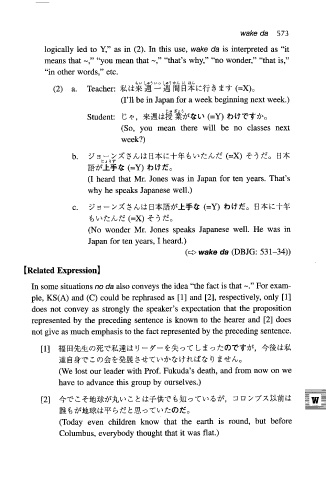Page 647 - Makino,Tsutusi.DictionaryOfIntermediateJGrammar
P. 647
wake da 573
logically led to Y," as in (2). In this use, wake da is interpreted as "it
means that -," "you mean that -," "that's why," "no wonder," "that is,"
"in other words," etc.
5w LwJ)br, LwjdlL I: IfL _,_
(2) a. Teacher: %L~~%~-%BB~B$~-.IT$~?(=X),
(I'll be in Japan for a week beginning next week.)
c* sr3
Student: C T , %%biE %PaL\ (=Y) blf Tb&
(So, you mean there will be no classes next
week?)
b. ~3t73$XS/viiB7P7G:++Bb~I~/v1Z(=X) ?-ifZo 8$
ZP+*& (=Y) blt E,
(I heard that Mr. Jones was in Japan for ten years. That's
why he speaks Japanese well.)
c. ~~-'/;CS/viiEl$E~~~~~(=Y)blff;Co El$C:+$
Bb>l:/vf (=X) ?-5 E,
(No wonder Mr. Jones speaks Japanese well. He was in
Japan for ten years, I heard.)
(+ wake da (DBJG: 531-34))
In some situations no da also conveys the idea "the fact is that -." For exam-
ple, KS(A) and (C) could be rephrased as [I] and [2], respectively, only [I]
does not convey as strongly the speaker's expectation that the proposition
represented by the preceding sentence is known to the hearer and [2] does
not give as much emphasis to the fact represented by the preceding sentence.

